H.H. Stuckenschmidt, writing of Schoenberg's Book of the Hanging Gardens, characterizes thus the impact of this song cycle: "An irrevocable step has been taken; with the Georgelieder the whole of modern music has entered upon a new phase of development."1 Certainly these songs, representative of the early part of Schoenberg's second, or atonal, period, attest to a notable departure from the sound, compositional technique, harmonic language, and vocal style of late romanticism. Such a departure did not occur without creating consequent analytical difficulties. Borrowing again from Stuckenschmidt, "chord-osmosis," "unanalyzable dissonance," and "a strange force of suction inherent in these sounds"2 are phrases that illustrate the degree of frustration experienced by analysts in approaching not only these songs, but also other atonal music of this period.
There have been thoughtful approaches to the analysis of atonal music, to be sure. Not to be ignored is the literature that has emerged from Allen Forte and like-minded analysts.3 These offerings perform an admirable service in outlining systems which might be used in the "pre-compositional" phase of atonal music composition. They also uncover interesting facts and correspondences which illuminate practices involving the use of pitch materials in atonal works. However, much of this analytical literature, due to its novel terminology and its dependence on numbers and mathematical operations (albeit simple operations), and because a certain acquaintance with these operations by the reader is sometimes assumed, is unlikely to be of practical accessibility to those who are not professional music theorists or composers with related interests. Many aspects of organization in the Opus 15 songs, however, lend themselves to discourse using standard terminology and with no invocation of mathematical analogs. It is the purpose of this paper to list some of the organizational aspects in this song cycle. Various unifying factors and controlling procedures that give coherence to melodic, harmonic, motivic, and formal events in this work will be considered.
One of the first items in Opus 15 that confronts the listener is the harmonic vocabulary Schoenberg has used. To those accustomed to twentieth-century music, the impression is of a harmonic style that employs dissonance freely, yet in a comparatively mild way. Also, after several hearings a feeling of harmonic unity becomes evident, although the precise nature of the sounds perceived may continue to be elusive. In fact, Schoenberg has been consistent with several types of harmonic constructions; these are shown in example 1.
Ex. 1. Unifying Sonorities.

These sonorities are well-used in the cycle as a whole; each appears as a discrete element in at least five different songs. In certain pieces, several of these harmonic types tend to dominate either the entire song, or a section therein. For example, sonority a2 is used repeatedly on different pitch levels within one section of Song VIII and within another section of Song XII, while the b2 sonority and the augmented triad, and to a lesser extent b1, dominate the entirety of Song VII. The prominence of these six sonorities contributes to a general condition of harmonic unity in Opus 15. This condition is aided by the identical spacing utilized for most appearances of these chords (an exception is the b1 chord, as noted in the example above, in Songs I and XIV). That these constructions are all three-note harmonies must also be conducive to homogeneity of sound.
Beyond these factors, certain intervallic characteristics in these sonorities should be noted. The a1 and a2 chords are intervallic mirror inversions of one another, as are b1 and b2. (The augmented triad, interestingly, is a sonority incapable of mirror inversion; it will sound the same, because of its unvarying intervallic construction, whether it is constructed upward or downward in major thirds from a given pitch.) More specifically, the a1 and a2 sonorities possess the same interval content4 as one another, as do also b1 and b2. This identity of interval content and the presence of the mirror inversion relationship in these chords guarantee an aural impression of close harmonic kinship. Harmonic unity, then, is served not only by the somewhat simple device of employing six intermittently-recurring sonorities throughout the song cycle, but also by the more complex procedure of devising four of these six sonorities as two sets of closely-related pairs.
The quartal chord and the augmented triad are of course not related by identical, or even similar, interval content. One might speculate that perhaps these two sounds are a bit more distinctive or easily recognizable than the other four. The augmented triad is a familiar sound to trained ears, and the quartal chord is an easily-recalled sonority. Perhaps Schoenberg wanted to extend the listener a greater opportunity to become familiar with the four other sounds, which are possibly not as distinguishable upon the first hearing.
One other harmonic factor must be mentioned, and that is Schoenberg's fondness for using the interval of the third, both major and minor, as a distinct harmonic unit in these songs. Thirds of course are constituents of harmonies a1 and a2, and also of the augmented triad. When presented as separate units, as shown in examples 2a and 2b (and below in example 21, in various measures of Song VII), they become another harmonically unifying factor.
Ex. 2a. Song XIII, meas. 6-8.

Ex. 2b. Song XIV, meas. 4-5.

Harmonic succession is in many styles a point of organizational unity, and several observations may be made concerning Schoenberg's technique in this regard. First, Schoenberg occasionally employs a type of harmonic passage in which one sonority is used exclusively or almost exclusively.
As shown in example 3a, Schoenberg has employed triads as discrete units in the upper staff of the accompaniment, while the lower staff consists largely of dyads in thirds.
Ex. 3a. Song III, meas. 16-19.

Example 3b illustrates a passage which is dominated in a harmonic sense by the a1 and a2 chords.
3b. Song XII, meas. 15-18.

Schoenberg sometimes uses a series of two or three harmonies as a sort of harmonic norm in a piece.5 The score of Song VII (example 21) offers a good example of this type of use, as appearances of the augmented triad are, with only one exception, always followed by either the b1 or b2 chords. In a somewhat similar sense, an alternation of harmonic thirds, moving by half-step, characterizes Song XIII.6 More specifically, the succession or alternation of the particular thirds Gb, G-flatB-flat and Gb, A-flatC is important, and acts as a norm of harmonic motion. (See example 4.) Note also the use of the b1 and a1 chords in measure 11.
Ex. 4. Song XIII, meas. 1-3, 6-8, 11-12, 13.
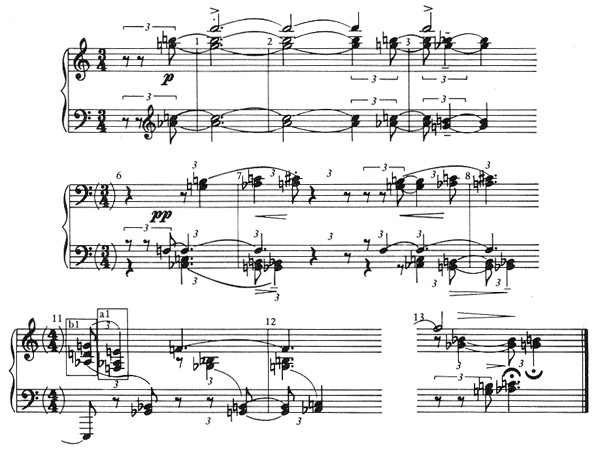
The idea of normal harmonic succession is expanded upon in certain songs, and becomes a formal technique used to restate characteristic elements or "round off" endings of pieces. Song VII (example 21) illustrates such form-influencing harmonic activity. Comparison of the last four and one-half measures with the first two and one-half will reveal the stabilizing influence of the progression used. Similar uses of harmonic succession are shown in examples 5 and 6.
Ex. 5. Song III, meas. 1, 24-26.

Ex. 6. Song V, meas. 1-6, 13-16.
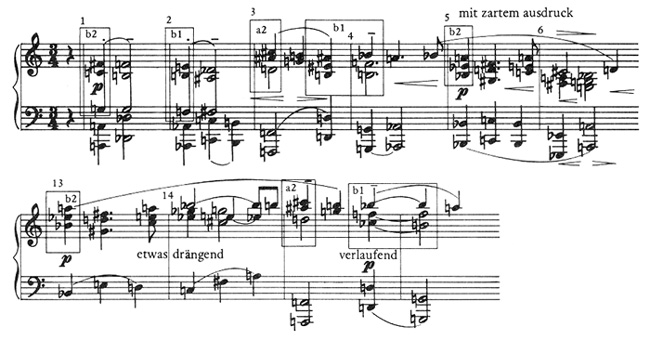
In Song III, the opening harmonies, varied somewhat, are used to end the piece. In example 6, the use of this technique is somewhat more complex. Measure 13 features harmonies used in measure 5, measure 14 is basically the same as measure 6 but transposed a major sixth higher, measure 15 is a restatement of measure 3, and measure 16 is a partial restatement of measure 4. Notice also the use of the a2, b1, and b2 chords here.
Many portions of these songs do not have a strong harmonic feeling, but rather a sense of linear or contrapuntal progression in which the movement of voices is governed by a certain motivic concern. Example 7 illustrates an instance in which three different types of motives prescribe a contrapuntal, primarily melodic, and only incidentally (if harmony may ever be said to be incidental) a harmonic type of movement.
Ex. 7. Song XI, meas. 14-15.
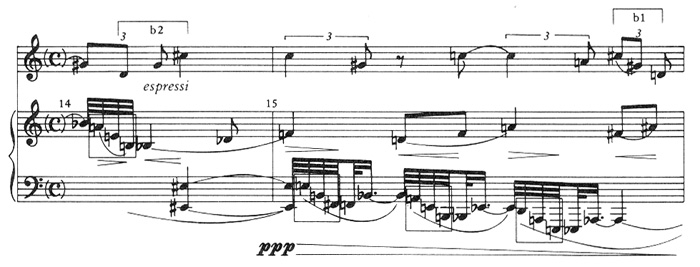
A motive which involves a linearization of both the b1 and b2 chords is present in the voice, another which outlines a minor triad can be heard in the piano, and still another, also in the piano, composed of sequential melodic outlinings of perfect fourths and quartal chords, is apparent.
An interesting instance of the use of a motive in contrapuntal fashion, combined with excessively accurate harmonic control, occurs briefly in the piano part of Song IX (see example 8).
Ex. 8. Song IX, meas. 11-12, 20-21.

Here Schoenberg, while giving expression to a strictly sequential motivic pattern, has tightly controlled his harmonic materials. Vertical intervals produced by simultaneously-struck pitches in the piano are limited to octaves, minor sevenths, and major sixths (or their enharmonic equivalents), in that order of succession. The vocal part features a few doublings of pitches used in the piano, but is otherwise oblivious to congruent pitch restrictions.
Later in the piano part of the same song an even more ingenious use of harmonic control is seen.
Ex. 9. Song IX, meas. 15-16, and reduction.
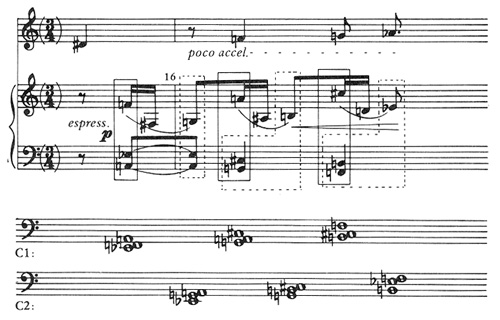
The motive in the previous example again appears sequentially, but here outlines an augmented triad through the initial pitches of each portion of the sequence. In the lowest staff, tri-tone dyads descend by whole tone. Schoenberg has controlled the harmony such that each sonority formed by simultaneously-struck pitches in the piano (those sonorities enclosed by solid lines in the example) is harmonically identical. This means that if each of these chords is arranged via harmonic inversion so that the shortest possible intervallic distance between the outer pitches obtains (a process analogous to placing triads in root position for purposes of comparison), the same harmonic structure is evident in each.7 The sonorities reached at the end of each statement of the short melodic motive (those chords enclosed by broken lines in the example) are also of identical harmonic structure with respect to one another. The reduction at the bottom of example 9 illustrates the harmonically identical quality of each of these two types of sonorities. (These chords will be called c1 and c2.) Schoenberg has thus produced the same set of sonorities on three different pitch levels while maintaining a strict melodic sequence, a compositional feat of some intricacy. The compliance of the governing melodic and harmonic elements in this passage with the whole tone scale (the augmented triad, the interval of the tritone, the whole tone descending motion of the tritone dyads, and the sonorities c1 and c2 are all contained in the same whole tone scale) partially facilitates the rigorous structure observed here. Again however, the vocal part is not included in the scheme of harmonic control, although the d-sharp, f, and g in measures 15 and 16 are elements of the prevailing whole tone scale.
Finally, further inspection of c1 and c2, the governing sonorities of the passage in example 9, reveals that these chords share the same interval content, and are also in a mirror inversion relationship. (See example 10.)
Ex. 10. Interval Content and Mirror Inversion Relationships of c1 and c2.

These two conditions, interestingly, are precisely the same for the a1-a2 and b1-b2 sonority pairs discussed earlier.
A final type of harmonic succession which Schoenberg uses in these pieces is that controlled by linear stepwise motion. Although some type of harmonic control may be in force, the vehicle for harmonic connection, the moving stepwise line, tends to establish itself as the normal means of progression. Example 11 provides an illustration.
Ex. 11. Song I, meas. 13-14, and reduction.
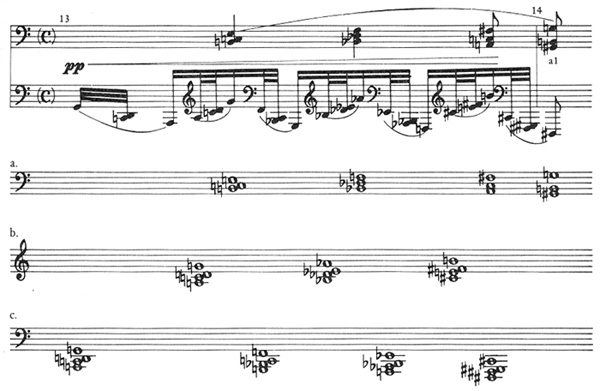
As is shown on staff "a" of the reduction, a three-voice stepwise movement, featuring contrary motion in the outer voices, takes place in the upper staff of measures 15 and 16. Activity in the lower staff of the same measures is represented on staves "b" and "c" of the reduction as two streams of four-voice harmony proceeding in contrary motion. These harmonic units are all connected by half- and whole-step motion, except for the second and third harmonies shown on staff "b." Notice the use of the now-familiar a1 chord as a temporary harmonic goal in the upper staff of measure 16.
Example 12 shows another linearly-influenced harmonic progression.
Ex. 12. Song X, meas. 28-32.

Here, linear motion characterizes movement in all voices during the first three measures of the example. The octave displacement in the lower staff of measure 30 does not destroy the feeling of stepwise motion. In measures 31 and 32, stepwise motion still connects most of what occurs in the upper staff.
In discussing chord connection in the last two examples, the focus has actually been upon somewhat contrapuntal, rather than purely harmonic, considerations. Let us now transfer completely from harmony to a discussion that deals with melodic organizational aspects; by way of continuity, an item of contrapuntal interest will introduce this topic.
Schoenberg's melody is often characterized as disjunct, proceeding in irregular contours, and employing dissonant intervallic progressions. These characterizations are to a certain extent accurate. In some cases, however, a more conjunct method of melodic organization can be seen, and heard, just beneath the surface of the music. Example 13 illustrates such a melodic passage.
Ex. 13. Song XII, meas. 23-26, and reduction.

These measures contain a type of melodic voice leading which can be reduced to two roughly parallel contrapuntal lines, as shown in the reduction. The irregularly-moving melody is in a sense an overlay upon smoother compound melodic motion. (Notice also the unfolding of the two similar melodic segments indicated with reference to the upper line of the reduction; this is a further underlying organizational feature in this passage.)
Example 14 offers a slightly more sophisticated version of this technique.
Ex. 14. Song VII, meas. 1-2, and reduction.

Here two different sets of contrapuntal lines are apparent. One involves a CC-flat and AA-flat progression, and the other a DE-flatF-flat and G-flatF-flatE-flat progression in contrary motion. Schoenberg by no means uses this implicitly contrapuntal type of melodic activity in a thoroughgoing way, but there are numerous vocal passages, and even more melodically-oriented accompanimental passages that reveal this sort of subsurface linear motion.
Schoenberg's vocal melodic motion is irregular, to be sure, but it is usually a controlled type of irregularity. In many cases the traditional melodic axiom of using predominantly conjunct motion and reserving disjunct motion for contrast or to call attention to climactic passages is followed. Song I offers an illustration; in the first nine of a total of thirteen measures of vocal writing (see example 15a) Schoenberg uses only four intervals larger than a major third, or its various enharmonic equivalents. (The larger intervals consist of a perfect fourth, a minor seventh, an augmented fourth, and an augmented fifth.) These wider intervals are employed, seemingly, to add a bit of strategic contrast to a melodic line which is otherwise characterized by seconds, thirds, and an arching contour that gradually rises an octave and then even more gradually falls to a point one-half step below the pitch on which it began.
Ex. 15a. Song I, meas. 8-16.

To throw into relief the song's coming climax, Schoenberg follows the above melodic passage with the largest leap in the piece. Even so, the effect of this large interval, an augmented eleventh, is mitigated because it occurs between two different phrases. After the climax on the high G-sharp in measure 17, Schoenberg employs a melodic line which is only slightly more disjunct than the one used in the first portion of the piece. From measure 18 onward (see example 15b), this line contains only two intervals larger than a major third or its enharmonic equivalents.
Ex. 15b. Song I, meas. 16-20.

Schoenberg's melodic style throughout the cycle is characterized by the aforementioned treatment. The majority of songs feature motion in seconds and thirds, with larger intervals for occasional contrast. Several of the songs are characterized by a more pronounced mixture of conjunct and widely disjunct motion, and in a few of these, a certain type of motion is confined to a particular place within the song. Only one song, Song VI, can be classified as primarily disjunct.
In every song in the cycle, there is at least some use of a strong lyrical melodic element characterized by flexible contours and by much melodic motion in small intervals. Schoenberg was at this point in his career, and was perhaps always, a writer of melodies of an expressive and romantic nature.
Motivic use is another aspect of organization. Schoenberg often uses melodic-rhythmic motives in standard ways to achieve a sense of coherence, or even of recognizable melodic development. Examples 7 and 8, previously referred to for other purposes, illustrate the use of such recognizable motives allied with the technique of sequence. Another instance of prominent motivic employment is shown in example 16. A distinct melodic-rhythmic motive appears in the voice and in the right-hand accompanimental part; The motive in the left-hand part is pronounced enough to begin to assume the role of an ostinato before it breaks off in measure 3.
Ex. 16. Song III, meas. 1-3.

An interesting use of a motive more as a basic shape than as a melodic-rhythmic entity is shown in example 17.
Ex. 17. Song I, meas. 1-8, 11-12, 17.

This motive, involving the successive presentation and contrast of a major and minor third in the opening measures, is referred to in subsequent portions of the piece, as shown above. These references are not literal, but invoke the motive's general contour. The original motive returns intact at the very end of the piece.
Pitch alteration is another of Schoenberg's techniques of motivic usage. Example 18 provides an instance of this procedure.
Ex. 18. Song XV, meas. 27.

Here, the motive introduced in the first half of the measure is altered rhythmically, and several pitches are altered or added; thus the span of the motive is slightly larger the second time than the first.
One other important aspect of motivic organization involves Schoenberg's consistency in presenting many of the same pitch constructions horizontally, as melodic configurations, and vertically, as harmonies. Chord b1 is presented melodically as well as harmonically in Song VII, as shown in example 19.
Ex. 19. Song VII, meas. 1, 9-11.

Chord b2 is presented harmonically and melodically almost at once, as shown in example 20.
Ex. 20. Song X, meas. 1-2.
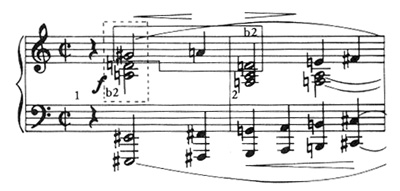
It is likely that the technique of presenting pitch entities both vertically and horizontally is a foreshadowing of one of Schoenberg's later postulations concerning the serial technique; that is that the tone row or pitch set is capable of producing harmonic as well as melodic constructions.
The four previous examples could all be used as illustrations of what may be termed Schoenberg's technique of "perpetual development,"8 a term which can be taken to mean simply not repeating anything in exactly the same way. Development or variation can occur either through pitch or rhythmic alterations, by interpolation of new materials while retaining a basic shape, or by stating a pitch entity both melodically and harmonically. In spite of the fact that many motivic and other units are simply repeated literally, as some of the previous examples have shown, it remains that the perpetual development technique is employed rather extensively in these pieces. Certainly the state of flux caused by the juxtaposition of perpetual development with the more stable technique of literal restatement is responsible for some amount of tension and drama in these pieces, and for the achievement of degree of variety.
A comment about form may now be in order. Schoenberg obviously realized that it was the form-building force of tonality which had enabled single movements and complete pieces of music to attain extended length. . Having virtually abandoned traditional tonality and most traditional types of harmonic organization in these pieces, Schoenberg undoubtedly felt challenged at the prospect of writing a fairly lengthy song cycle. The songs of Opus 15 indicate a certain mastery of problems of length, as the entire cycle comprises a great deal of musical material. The cycle as a whole has its own sense of progression from one song to the next, involving various tempos and characters, with the climax of the entire work perhaps being the eighth song, which is the fastest and most virtuosic. But more interesting and more telling with respect to Schoenberg's form-building skill at this point in his output is the manner in which he handles form in each song individually. It is quite apparent, since all of these songs are short (the longest is the last song, at 51 measures), that Schoenberg still did not feel overly confident in attempting an extended movement with a sustained application of the type of writing style discussed here.
That Schoenberg restricts himself to short, formally closed pieces within the cycle means that he is free to concentrate to a great extent on form-producing aspects which heretofore would have been considered subtle, too subtle for an extended piece of music, but which are quite suitable for a short work. "Subtle form-producing aspects" denote such techniques as those already discussed concerning melody and harmony: slight variations of motives, use of motives as basic shapes, statements of the same pitch constructions horizontally and vertically, restatements of characteristic sonorities in the same voicings and spacings throughout a piece, and in some cases restatements of sonorities on the same, untransposed pitch level. To these subtle aspects, which would of themselves probably go unnoticed as major formal elements in a larger piece, can be added the more direct form-engendering aspects of simple repetition, restatement, and contrast. These Schoenberg does employ, but not to excess.
Song VII will serve as an example to illustrate concretely some of the techniques just mentioned. Some general comments about formal organization in other songs may be made first, however.
Ex. 21. Song VII.
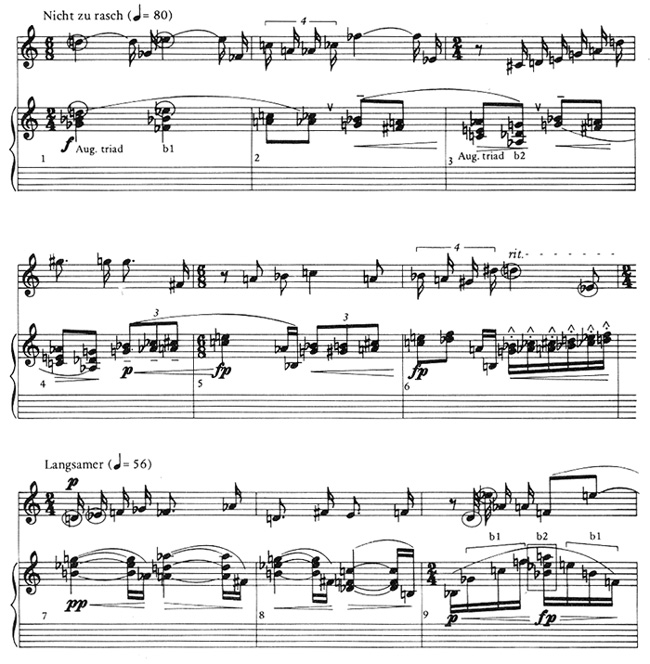
.jpg)
Most of the songs feature some sort of return of opening material at or near the end. Sometimes the last few measures reflect exactly what has happened in the first measure, as in Song VII; sometimes the first and last few measures share the same material, but in a re-ordered way, as in Song II, or in otherwise varied restatements, as in Song III. In many songs, there is internal restatement of material that was employed at the beginning or in the interior of the piece, as in Song V. Each piece contains at least some elements of restatement, more literal in some, more varied in others, more prominent in some, not as evident in others. This largely unpatterned restatement of literal and varied material is at the heart of Schoenberg's success with the ambivalent, subtle, initially almost imperceptible and yet intuitively felt sense of formal organization in these pieces. Perhaps this is why Schoenberg stated, regarding these songs, that he was "for the first time successful in coming near an ideal of expression and form which I had had in mind for years."9
As a final point of discussion let us consider Song VII, which exemplifies many formal characteristics found in each of these short pieces. In the interest of concise presentation, some overlapping occurs between several items mentioned below and earlier allusions to this song. Repetition and restatement are important form-producing techniques in Song VII. Repetition is evident in the accompaniment in measures 2½-3 and 3½-4, in measures 13½-14 and 14½-16, and rhythmically in measures 7 and 8. Varied restatements of motives or shapes occur in the vocal part; measure 6, for example, tends to summarize the melodic activity and motion, including some of the actual pitches used, in measures 1 and 2. Measure 7 refers to and develops the type of motion utilized in measure 3. Measures 9 and 10 deal with the type of activity found earlier in measures 1, 2, and 6. Some use of contrast is also evident in the vocal part; the largely disjunct motion in measures 1 and 2 contrasts with the combination of stepwise and leaping motion in measures 3 and 4. Variation and developmental activity are also found in the accompaniment. The second half of measure 3 through measure 16 is in a sense a development of what is stated in the first one and one-half measures of the piece. A shorter internal instance of development occurs between measures 4½ and 6, where a short triplet-quarter note motive is lengthened and rhythmically altered, and then leads to contrasting material in measure 7. The accompanimental activity in measures 7 through 13 is texturally and rhythmically a contrast to all of the previous material in the piano part, though some of the earlier pitch material is shared.
A bit of development also takes place in the accompaniment in measures 9 through 11. Here, through a technique of interpolation, the original motive in measure 9 is lengthened in 10 and the first half of 11. Notice the melodic outlining of the b1 chord, and the use of the b2 chord on the second beat of measures 9 and 10. It is also noteworthy that this same b2 chord appears an octave lower, and the end of measure 16, to begin the accompanimental coda of this song.
Of great importance is that the harmonic-melodic ideas in the initial two and one-half measures of the accompaniment occur again in the final six and one-half measures. Also, the last four harmonies in the song are restatements at the exact pitch level of sonorities which occurred initially in measures 1 and 3; this is a feature which provides no small amount of formal unity in this short piece.
In addition to these factors, there is one other important unifying feature which is very perceptible to the ear. This is the focus on the pitches D and E-flat, including the directional aspect of D moving to E-flat, as demonstrated by the circled pitches in the score in measures 1 (both voice and accompaniment), 6, 7, and 9 (in the voice), 16 (between piano and voice), and 18-19 (piano only). Also of importance is that the first vocal phrase of the song begins on D and ends on E-flat, as does the entire vocal line of the song. The emphasis on these two pitches throughout the piece as invariant elements is certainly another point of unity and a form-producing feature, as is the suggestion of the established pitch order of D progressing to E-flat.
Not all of the songs are organized as comparatively clearly as number VII, but many of the same formal techniques are evident in them. A combination of subtlety and directness in the use of literal and varied restatement, plus the judicious use of contrast, is responsible for the sense of unity in this song cycle, a sense which one can perceive even at the first hearing.
In summary, Schoenberg in Opus 15 has written a collection of songs wherein organization of pitch material, melodic motion, motivic treatment, and formal relationships is quite concentrated, though the actual presentation of these features in the music is often subtle. If in this discussion various organizational aspects have overlapped somewhat, if when considering form we seem to have been considering harmony from a different viewpoint, or if, when discussing motives we seem to have been discussing form from a different perspective, then the situation probably is as Schoenberg would want it. Elements of harmonic, melodic, motivic, and formal organization are very tightly bound together; in attempting to discuss an isolated aspect we become aware that such an aspect is not isolated at all, but is merely a facet of a larger unit of musical organization whose surface is comprised of more than one side. Perhaps this superb integration of elements is one of the factors that Schoenberg recalled when he mentioned in the program for the song cycle's first performance, "Now that I have finally embarked upon this path I am conscious that I have broken all barriers of a past esthetic."10 It is clear that the songs of the Book of the Hanging Gardens embodied a new, valid, and aurally accessible method of musical organization.
Quotations from Arnold Schoenberg's Das Buch der hängenden Gärten von St. George, Opus 15, used by permission of Belmont Music Publishers, Los Angeles, California 90049.
1H.H. Stuckenschmidt, Arnold Schoenberg, trans. by Edith Temple Roberts and Humphrey Searle (London: John Caulder Ltd., 1959), p. 48.
2Ibid., p. 46.
3See notably Allen Forte, The Structure of Atonal Music (New Haven and London: Yale University Press, 1973).
4The interval content of a sonority is an expression of the total number of each type of interval present in that sonority. Interval content is customarily expressed in terms of the number of intervals contained in each of six "interval classes." The first interval class embraces the m2 and its inversion the M7. Class two embraces the M2 and m7, class three the m3 and M6, class four the M3 and m6, class five the P4 and P5, and class six the augmented 4th and diminished 5th. Other augmented or diminished intervals are equated to their major, minor, or perfect enharmonic equivalents. Thus sonorities a1 and a2 both have an interval content of one class one, one class three, and one class four interval, while b1 and b2 have an interval content of one class one, one class five, and one class six interval. See Forte, The Structure of Atonal Music, pp. 13-15.
5For a discussion of what are called harmonic "normals," see Edward T. Cone, "Sound and Syntax: An Introduction to Schoenberg's Harmony," Perspectives of New Music, Fall-Winter 1974, pp. 22-23. See also pp. 33-37 of this article for a discussion of harmony and harmonic normals in Schoenberg's Opus 15.
6For a related discussion see Cone, pp. 33 and 35.
7The operation of placing sonorities into an arrangement such that their outer pitches are maximally close facilitates comparison of harmonic properties, This maximally-close spacing is called "normal order" by Allen Forte. For further explanation, see his The Structure of Atonal Music, pp. 3-5. Although some analytic procedures outlined in Forte's book are used in this study, the reader is cautioned that the present paper is not a reflection of strict adherence to nor consistent application of methodologies presented in The Structure of Atonal Music.
8See René Leibowitz, Schoenberg and His School, trans. by Dika Newlin (New York: The Philosophical Library, Inc., 1949), pp. 57-59. Schoenberg himself refers to a related technique of motivic development with the term "developing variation"; see his Style and Idea, Leon Stein, editor, trans. by Leo Black (New York: St. Martin's Press, 1975), pp. 129, 248. Also see a related discussion on pp. 102-104.
9Stuckenschmidt, Arnold Schoenberg, p. 45.
10Ibid., p. 45.


